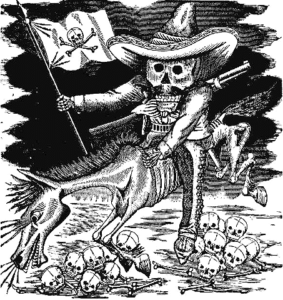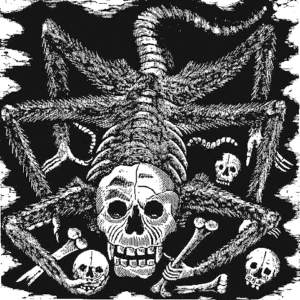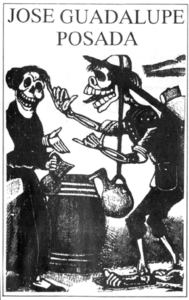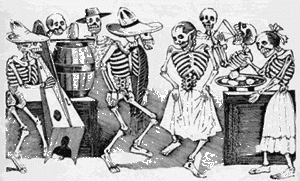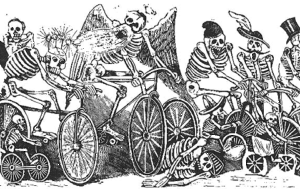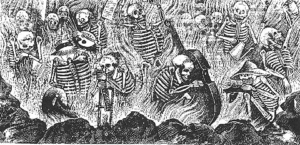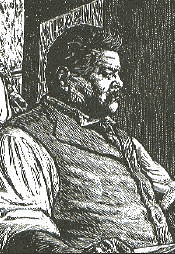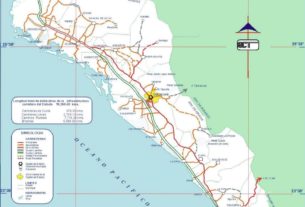November 2 is “El Dia de los Muertos” (the Day of the Dead) and Jose Guadalupe Posada, or “Don Lupe” as he was known to his friends, a poor but prolific printmaker, will come alive once again in the hearts and minds of the Mexican people.
Gallery: The calaveras of José Guadalupe Posada
No Day of the Dead celebration would be complete without a nod to that artist genius who turned death into an expression of vibrant life that refuses to die year after year. Without Posada there would be no sexy, stiff-necked “Catrina” figures (upper class ladies of the late nineteenth century) with their equally stiff escorts. Nor would there be those vibrant dancing skeletal figures or saucy female skulls in turn-of-the-century hats on the colorful ” papel picada” (cut paper) that decorates the altars to celebrate the day. In fact, it would impossible to imagine a Day of the Dead market place, which always opens several weeks before the holiday, without these lively, irreverent bits of folk art.
It would also be hard to picture these characters in mini skirts or jeans. They are frozen in the era in which they first came to life, a tribute to the powerful influence Posada exerted in his time.
Skeletons were always a part of the day of the dead celebration, and many artists used them as symbols before Posada. However, it was Posada who gave life to these figures infusing them with energy and humor.
Andre Breton observed in his Anthology of Black Humor that humor doesn’t appear in the visual arts tradition of the west except in some of the works of Goya and Hogarth. “The triumph of humor in its pure and full state,” he wrote, “must be dated closer to our time and must recognize as its first genial artisan, the Mexican artist, Jose Guadalupe Posada…” Humor in modern art begins with Posada.
Besides his obvious humor, his figures have an expressionistic quality that goes beyond the ordinary visual or narrative reconstruction of an event. He was able to capture the essence of an incident, an awareness not yet exploited in the artists before him. His perception foretold a new philosophy, a new aesthetic. It predated the expressionist movement begun in Europe a number of years later.
Jose Guadalupe Posada has been referred to as the father of the muralist movement. Both Jose Clemente Orozco and Diego Rivera have said that Posada was a determining influence in their careers and sense of aesthetics. For his influence on them and that whole generation of younger artists, he is recognized as one of the great precursors of the Mexican School of Modern Art. Although he died in 1913, he was thought of as a contemporary by these later talents. Even art history books have a hard time placing him in his time. He is often in a category by himself.
Though Posada’s figures look deceptively simple, he was a consummate craftsman. His engravings achieve their coarse, hand crafted appearance through deliberate manipulation of sophisticated processes. He mastered the art of lithography while still a young man, and by the time he began working for Antonio Vanegas Arroyo, he was highly skilled in engraving in metal and etching in zinc, a process he introduced to Mexico around 1895 and he alone employed.
The meeting of Jose Guadalupe Posada and Don Antonio Vanegas Arroyo was fortuitous for both men. Vanegas Arroyo had the best publishing house in Mexico, and he employed Posada as an illustrator for his street gazettes called broadsheets or broadsides. These one-sheet newspapers were written for the underprivileged and semi-iliterate during the time of Porfirio Diaz. In those oppressive times, it included the majority of the population.
Broadsheets were sold in the plaza, on the streets and in the market place for a penny a piece. They were the newspaper of the poor working class and expressed their frustrations, fears, angers, and aspirations. Posada identified with these people. He lived among them and represented their collective voice.
His work dealt with political, social, and moral themes. Murders, disasters, revolts, and popular heroes were all material for broadsheet publication. Crimes were of great interest, and the most sensational, unusually brutal crimes sold especially well. In fact crime comprised more than half the work produced by Vanegas Arroyo. The escapades of rural bandits were so popular that even years after their deaths, copies of their stories continued to be sold. Women were of particular interest, and the broadsheets of their crimes outnumbered all other incidences.
Disasters were second to crime. Posada knew by intuition and by experience what attracted the attention of the ordinary person. Each day he illustrated some noteworthy event that dealt with accidents, earthquakes, fires, or floods
He also illustrated the broadsheets of “corridos”, ballads that mostly glorified bravery, bandits and bullfighters. Sometimes they told of the stories of ordinary men and women, and often they warned of the hidden powers of the opposite sex.
Another theme that Posada exploited was religious handbills, a great favorite of the people. They recounted wonderful miracles or told tales of transgressions and punishment. They carried the images of religious figures that were regarded as potent sources of divine mercy. In executing these figures, Posada showed he could be reverent and well as satirical.
In addition to broadsheets, the poor of Posada’s Mexico purchased songbooks, games, collections of tricks and riddles, and children’s stories. Posada knew the customs and traditions of his people and, through his illustrations, gave back to them that which he gathered from the people themselves. His engravings and etchings adorn the covers of countless booklets of children’s plays, riddles, and stories.
He carried an engraving block and a burin in his pocket and would ask for work and produce required pictures on the spot. He rarely signed his prints and never thought of himself as an artist. He saw himself as a technician, a printmaker, and a competent draftsman. Historians say that by the time he died he had produced between 15,000 and 20,000 prints.
Though his work consisted of more than the calaveras animated skeletons were his main vehicle of expression and what he is most recognized for. He used the “calaveras” to mock human existence and express the tragic destiny of man. His skeletons portrayed famous heroes, politicians, revolutionary leaders, and the common person. They showed the horrors of war and the injustices of the Diaz regime. And mostly they showed that rich or poor, all paths lead to the grave – the great equalizer.
Posada’s “Calaveras” personify Mexico’s unique relationship with death. It seems only fitting to do homage to this humble genius in the weeks leading up to the Day of the Dead celebration. This year, on the second of November, Posada, with his wonderful array of skeletal beings, will be on my altar helping me celebrate the man who gave so much to the celebration.

